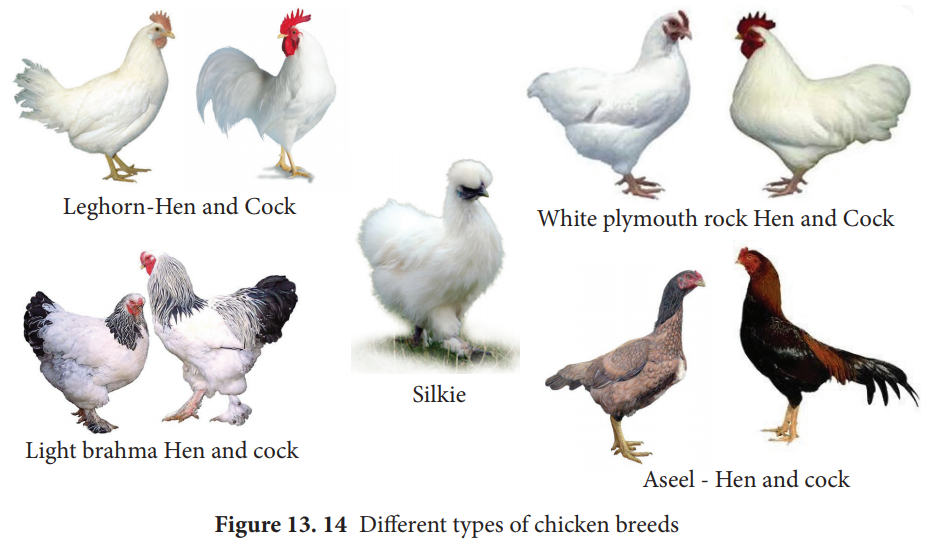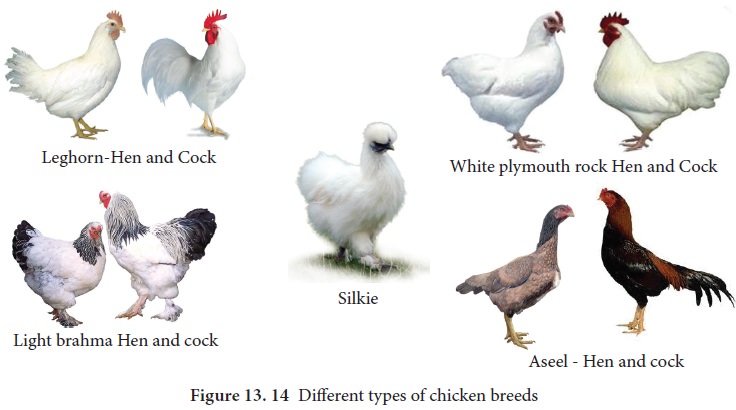Chapter: 11th Zoology : Chapter 13 : Trends in Economic Zoology
Poultry Farming

Poultry Farming
The word poultry refers to the rearing and
propagation of avian species such as chicken, ducks, turkeys, geese, quail and
guinea fowls. The most common and commercially farmed birds are chicken and
ducks. Poultry farming is essential for the purpose of meat, eggs and feather
production. Commercial poultry farming is also profitable. In this part we are
discussing about an overview of the chicken and duck breeds, farming practices
and its advantages.
Types of
Chicken breeds: There are more than 100 breeds. The commonly farmed chicken breeds are categorized into
five based on the purpose for which it is farmed. They are egg layers, broiler
type, dual type, games and ornamental types (Figure 13.14).
![]()
1. Egg
layers: These are farmed mainly for the production of egg.
Leghorn: This is
the most popular commercial breed in India and originated from Italy. They are small, compact with a
single comb and wattles with white, brown or black colour. They mature early
and begin to lay eggs at the age of 5 or 6 months. Hence these are preferred in
commercial farms. They can also thrive well in dry areas.
Chittagong:
It is the
breed chiefly found in West Bengal. They are golden or light yellow coloured. The beak is long and
yellow in colour. Ear lobes and wattles are small and red in colour. They are
good egg layers and are delicious.

2. Broiler
type: These are well known for fast growth and soft quality meat.
White
Plymouth rock: They have white plumage throughout the body. It is commonly used in broiler production.
This is an American breed. It is a fast growing breed and well suitable for
growing intensively in confined farms.
3. Dual
purpose breeds: These are for both meat and egg production purpose.
Brahma: It is a
breed popularly known for its massive body having heavy bones, well feathered and proportionate body. Pea
comb is one of The important breed characters. It has two common varieties
namely, Light Brahma and Dark Brahma.
4. Game
breeds: Since ancient times, special breed of roosters have been used for the sport of cockfighting.
Aseel: This
breed is white or black in colour. The hens are not good egg layers but are good in incubation of eggs. It is
found in all states of India. Aseel is noted for its pugnacity, high stamina,
and majestic gait and dogged fighting qualities. Although poor in productivity,
this breed is well-known for their meat qualities.
5. Ornamental
breeds: Ornamental chicken are reared as pets in addition to their use for egg production and meat.
Silkie : It is a breed of chicken has a typical fluffy plumage, which is said to feel like silk and satin.
The breed has numerous additional special characters, such as
black skin and bones, blue earlobes, and five toes on each foot, while the
majority chickens only have four. They are exhibited in poultry shows, and come
out in various colours. Silkies are well recognized for their calm, friendly
temperament. Silkie chicken is especially simple to maintain as pets.
Types of
Poultry farming: There are different methods used to rear both broiler
and layer chicken. The types of
poultry farming are Free range farming, Organic method, Yarding method, Battery
cage method and Furnished cage method
Among these, Battery cage method is widely used in
large scale poultry farms. The Free range, Organic and Yarding methods are eco-
friendly and the eggs produced by such farming practices are preferred in the
market.
Stages involved in rearing:
There are some steps involved in rearing of
chicken.
1. Selection
of the best layer: An active intelligent looking bird, with a bright comb, not
obese should be selected.
2. Selection
of eggs for hatching: Eggs should be selected very carefully. Eggs should be
fertile, medium sized, dark brown shelled and freshly laid eggs are preferred
for rearing. Eggs should be washed, cleaned and dried.
3. Incubation
and hatching: The maintenance of newly laid eggs in optimum condition till
hatching is called incubation. The fully developed chick emerges out of egg
after an incubation period of 21 – 22 days. There are two types of incubation
namely natural incubation and artificial incubation.In the natural incubation
method, only a limited number of eggs can be incubated by a mother hen. In
artificial incubation, more number of eggs can be incubated in a chamber (Incubator).
Brooding
Caring and management of young chicks for 4– 6
weeks immediately after hatching is called brooding. It can also be categorized
into two types namely natural and artificial brooding.
Housing of Poultry
To protect the poultry from sun, rain and predators
it is necessary to provide housing to poultry. Poultry house should be
moisture- proof, rat proof and it should be easily cleanable and durable.
Poultry feeding:
The diet of chicks should contain adequate amount of water, carbohydrates, proteins, fats,
vitamins and minerals.
Poultry
products: The main products of poultry farming are eggs and meat. In India, the primary aim of poultry farming is
to obtain eggs. The eggs and poultry meat are the richest sources of proteins
and vitamins.
Poultry byproducts:
The feathers of poultry birds are used for making
pillows and quilts. Droppings of poultry can be used as manure in fields. The
droppings are rich in nitrogen, potash and phosphates.
A number of poultry byproducts like blood-meal,
feather meal, poultry by-product meal and hatchery by-product meal are used as
good sources of nutrients for meat producing animals and poultry. These
byproducts supply proteins, fats, vitamins and good amount of minerals.
Poultry
diseases: Ranikhet, Coccidiosis, and Fowl pox are some common poultry diseases.
Benefits of Poultry farming:
The advantages of poultry farming are
a)
It does not require high capital for construction
and maintenance of the poultry farming.
b)
It does not require a big space.
c)
It ensures high return of investment within a very
short period of time.
d)
It provides fresh and nutritious food and has a
huge global demand. It provides employment opportunities for the people.
Related Topics